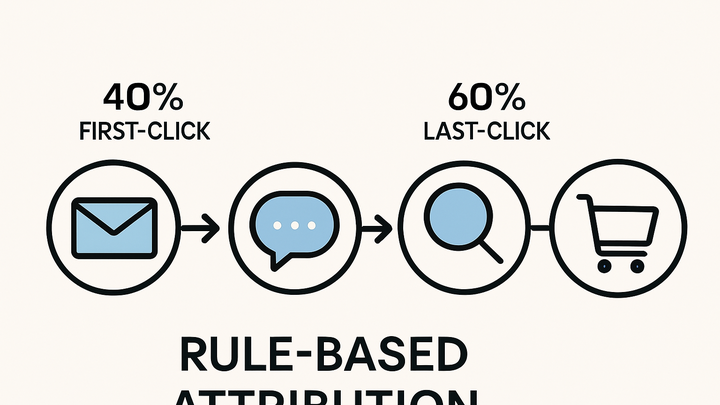Published on 2025-06-26T04:44:15Z
What is Rule-Based Attribution? Examples for Rule-Based Attribution.
Rule-Based Attribution is a methodology in digital analytics where conversion credit is distributed across marketing touchpoints according to a set of predefined, manual rules. Unlike algorithmic or data-driven approaches, rule-based models rely on marketer-defined logic—such as first-click, last-click, linear, or time-decay—to assign credit. This model offers transparency and simplicity, making it easy to understand how each touchpoint contributes to conversions. However, because it uses fixed weights, it may oversimplify complex customer journeys and fail to adapt to changing user behavior. Rule-based attribution is ideal for teams seeking a straightforward framework to evaluate campaign performance and for businesses with clear attribution preferences. Popular analytics platforms like Google Analytics 4 (GA4) and PlainSignal support various rule-based models to help marketers implement these insights.
Rule-based attribution
Assigns conversion credit based on predefined rules for a transparent, easy-to-understand alternative to data-driven models.
Overview of Rule-Based Attribution
Rule-based attribution allocates conversion credit according to fixed rules defined by marketers rather than dynamic algorithms. It provides clear, straightforward insights into which touchpoints drive conversions based on models like first-click or last-click. This approach is highly transparent and easy to implement. However, it may not capture the nuanced interplay between multiple channels in complex customer journeys.
-
Definition
Rule-based attribution is the process of assigning conversion credit to marketing touchpoints according to fixed, user-defined rules.
-
Key characteristics
It uses transparent, pre-set weighting rules that are easy to understand and apply consistently across campaigns.
-
Customizable rules
Marketers can define which touchpoints receive credit and how much.
-
Fixed weights
Weights remain constant regardless of data patterns.
-
Common Rule-Based Models
Several standard attribution models fall under rule-based attribution. Each applies a different logic to distribute conversion credit across the customer journey.
-
First-click attribution
Gives all conversion credit to the first touchpoint in the customer journey.
-
Best for
High-awareness campaigns where initial engagement is crucial.
-
Limitation
Ignores the impact of later interactions.
-
-
Last-click attribution
Awards 100% of credit to the final touchpoint before conversion.
-
Best for
Campaigns focused on the final purchase step or retargeting.
-
Limitation
Overlooks earlier engagement’s role.
-
-
Linear attribution
Distributes credit equally across all touchpoints.
-
Best for
Simple, multi-step journeys where every touchpoint matters.
-
Limitation
May undervalue pivotal interactions.
-
-
Time-decay attribution
Applies increasing credit to touchpoints closer to conversion based on a decay function.
-
Best for
Long customer journeys with increasing intent nearer to conversion.
-
Limitation
Requires specifying a decay rate which can be arbitrary.
-
-
Position-based attribution
Allocates a set percentage of credit to the first and last touchpoints, distributing the remainder evenly among middle interactions.
-
Best for
Journeys that prioritize both awareness and conversion steps.
-
Limitation
Arbitrary weight split may not reflect true influence.
-
Implementing Rule-Based Attribution in Analytics Tools
You can configure rule-based attribution models in various analytics platforms. Below are examples in Google Analytics 4 (GA4) and PlainSignal.
-
Google analytics 4 (GA4)
GA4 lets you select rule-based models for conversion reporting through its Attribution Settings.
-
Setup steps
Navigate to Admin > Attribution Settings. Choose your desired rule-based model (e.g., First click, Last click). Save your configuration.
-
Example configuration
Select ‘Last click’ to credit the final touchpoint in acquisition and conversion reports.
-
-
PlainSignal (cookie-free simple analytics)
PlainSignal provides a lightweight, cookieless analytics snippet and allows you to pick a rule-based model in the dashboard.
-
Tracking code
Include this snippet in your site’s <head> to enable PlainSignal analytics:
-
Example code
<link rel="preconnect" href="//eu.plainsignal.com/" crossorigin /> <script defer data-do="yourwebsitedomain.com" data-id="0GQV1xmtzQQ" data-api="//eu.plainsignal.com" src="//cdn.plainsignal.com/plainsignal-min.js"></script> -
Model selection
In PlainSignal’s dashboard, go to Attribution Settings and choose your preferred rule-based model.
-
Pros and Cons of Rule-Based Attribution
While rule-based attribution models are straightforward and transparent, they come with trade-offs.
-
Advantages
Rule-based attribution offers clear benefits:
-
Transparency
Weights and rules are explicit and easy to understand.
-
Ease of implementation
Requires minimal configuration and technical overhead.
-
Flexibility
Custom rules can be tailored to specific business objectives.
-
-
Disadvantages
However, there are limitations to consider:
-
Oversimplification
May not capture the complexity of multi-channel interactions.
-
Static weights
Fixed rules can become outdated as customer behavior evolves.
-
Potential bias
Prioritizing certain touchpoints may underrepresent others’ impact.
-
Best Practices for Using Rule-Based Attribution
To maximize the effectiveness of rule-based attribution, follow these guidelines.
-
Align models with business goals
Choose attribution rules that reflect your marketing objectives, such as awareness or consideration.
-
Regularly review attribution rules
Periodically validate your models against actual performance metrics and adjust as needed.
-
Combine with other insights
Use qualitative data and algorithmic analysis to complement rule-based insights for a fuller picture.
